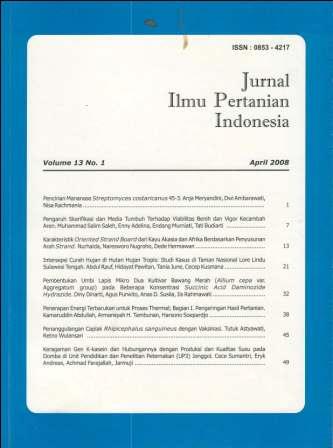Penerapan Energi Terbarukan untuk Proses Thermal Bagian I. Pengeringan Hasil Pertanian
Abstract
Study on thermal processes using renewable energy sources for drying and cooling purposes hasc been selected due to their importance in extending shelf life of agro and marine products which arc susceptible to high temperature and humidly under the tropical climatic conditions. The unavailability of these facilities had resulted in significant amount post harvest which sometime may reached up to 30% of harvest. This research was aimed to determine the proper design and construction of renewable energy conversion, namclyt, solar, wind and biomass to generate thermal energy for drying and cooling of agricultural and marine produccts. Both processes could also be used as the main component of a Small Processing Unit (SPU), an early form of SME and cooperative at village level. This paper will discuss Part I of the study which will be focused on the application of renewable energy sources for the drying of agricultural products. The following conclusions had been achieved. a). Study on simultaneous momentum, energy and mass transfer in thin layer drying process of rough rice have provided information on air temperature, velocity and RH distribution above the grain. b). A novel ventury type CIIE solar dryer with solar PV power supply and PCM energy storage, has been successfully designed and constructed. Test results have shown that the dryer could he used to dry 75-95kg of fish within 36 to 40 hrs. wirh apparent PCM energy storage of 6.9M.J (6 hrs. drying time). c). Mathematical modelling and simulation of a biomass stove heated recirculation dryer indicated that drying of rough rice could be completed within 3-6hrs (1.8-3.7T.hrs-1 recirculation rate with one hour
tempering time) if 2 HP blower is used.
Keywords : energy storage, momentum and mass transfer, recirculation dryer, renewable energy conversion, simultaneous energy
Downloads
This journal is published under the terms of the Creative Commons Attribution-NonCommercial 4.0 International License. Authors who publish with this journal agree to the following terms: Authors retain copyright and grant the journal right of first publication with the work simultaneously licensed under a Creative Commons Attribution-NonCommercial 4.0 International License. Attribution — You must give appropriate credit, provide a link to the license, and indicate if changes were made. You may do so in any reasonable manner, but not in any way that suggests the licensor endorses you or your use. NonCommercial — You may not use the material for commercial purposes.



















